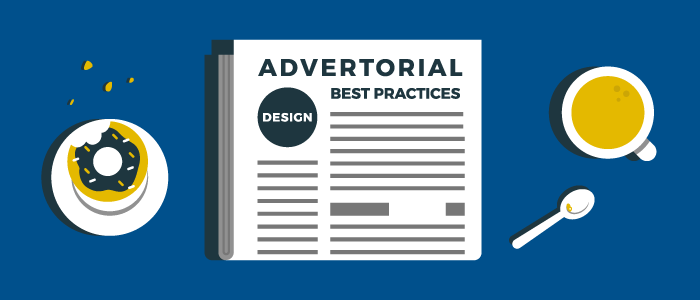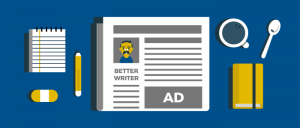
Advertorial, native ad, sponsored content, custom content—tomato, tomahhhto—it’s all a similar scenario: a publisher creates and/or publishes content paid for by a sponsor. Regardless of how we refer to it, we’ve been doing it since publishers started selling ads on paper, and better advertorial design has come into vogue over the past few years now that ad dollars are being spent more online.

Advertorial design best practices are relatively simple because the FTC gives us guidelines:
“In evaluating whether an ad’s format is misleading, the Commission will scrutinize the entire ad, examining such factors as its overall appearance, the similarity of its written, spoken, or visual style to non-advertising content offered on a publisher’s site, and the degree to which it is distinguishable from such other content,” the FTC says in its policy statement.
[text_ad]
I think it’s important to understand that the FTC’s rules for advertorial design is quite clear: if it doesn’t look like an ad, you’re in trouble.
- Articles must disclose that the article was paid for by a sponsor, and this disclosure should be visible no matter where the user is scrolled down to on the page.
- The author area is another excellent place to include this disclosure.
- Creating excellent content is the best way to please readers who see the label of “sponsored content” or “advertisement” when they open an article.
- Design high-end graphics and use images that match the quality of the rest of your content, again, so readers trust your content.
- Don’t allow shameless self-promotion throughout your advertorials, save it for the end when necessary.

When your advertising revenue model includes selling advertorials, a superior ad sponsorship package begins with the piece your sponsors crave the most and is also the part publishers have the expertise to provide – content. Advertorials present a unique opportunity for publishers. Advertisers crave an audience to showcase their expertise, or thought leadership, and multiplatform publishers, especially those using a Mequoda portal and HTML magazine in addition to print and tablet versions, have the capacity to deliver a large, high-value audience.
Because of the advertorial design guidelines that were created in 2015 via the FTC’s Native Advertising: A Guide for Businesses advertorials strike fear into the hearts of many. It’s no wonder after some of the high profile mistakes that other publishers made. Indeed, when done incorrectly, advertorials can damage your brand and cost you the trust of your audience and your sponsors.
But it really is not difficult to do correctly. Advertorials that offer fantastic editorial that doesn’t turn off the reader as being too promotional or non-contextual can be a natural part of your editorial program. Plus, the FTC hasn’t changed their rules since 2015, so it’s not a moving target.
At Mequoda, we believe the best advertorial takes the same form and qualities as your original premium content — one of the main reasons we prefer to use the term “sponsored content.” The content should provide value for the reader at the same time as it creates a positive perception of the sponsor. We live with one simple watch phrase that can help keep you out of trouble: advertorials should be something your publication would have published regardless of whether there was a sponsor. If it doesn’t meet that simple test, you shouldn’t publish it.

The good news is that creating this kind of content isn’t easy for a sponsor. Most sponsors can’t resist the opportunity to write promotional ad copy, instead of content that will really engage readers. They can’t help but emphasize the “ad” in “advertorial.” That’s why we recommend that the content be generated by someone you trust, who also knows your audience – you! And even though you will be the ones generating the content, it will still be labeled as “Sponsored Content.” Most readers won’t care if the content is sponsored or not – as long as it’s good!
Mequoda recommends using your own editorial resources – for a price – to create copy you know works for your audience and meets the needs of the sponsor. The best examples of these partnerships begin with a conversation where the publisher asks questions about what the sponsor wants to accomplish – and listens more than talks. After taking the sponsor’s needs into consideration, the publisher can come back with a specific content proposal that satisfies the sponsor and meets the publisher’s need for quality content.
The importance of this agreement can’t be overstated. If it doesn’t help your audience, or if the content doesn’t meet the sponsor’s needs, no one will be happy. Make sure you communicate early and often with the sponsor to ensure everyone is informed of what the other is doing, and get buy-in from the sponsor for the content plan.
For more advertorial design ideas, read a few more of our articles:
How to Write Native Content Advertising for a Magazine Sponsor
Learn how to write more effective native content advertising for a sponsor and start getting paid more for content.
Hugely Successful Advertorial Examples You Can Learn From
With these new-age advertorial examples, you’ll re-think your native advertising game.
The Best Advertorial Definition & Examples That Will Inspire You
Prime Publishing shows what a good advertorial example is made of, done a little differently.
How has the FTC’s updates to native ads affected the way you design advertorials? Leave a comment and let us know.



I have read your content, and have to be able to say – this
particular is a actual gem. The previous time I’ve
appear across something equally well-written was http://writemypaperforme.info/. Your material is really a fantastic read,
thank you. Wish you the large audience plus inspiration for a lot
more posts.